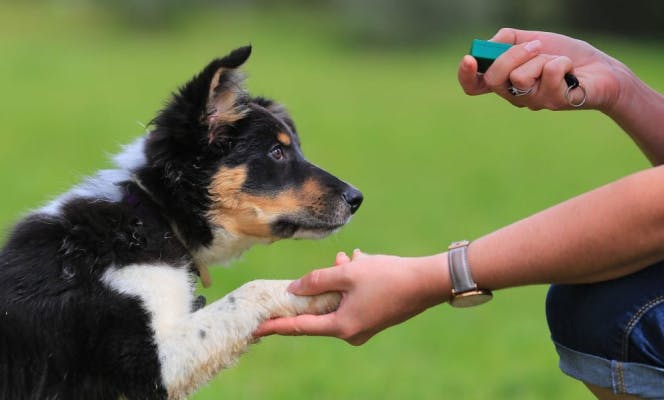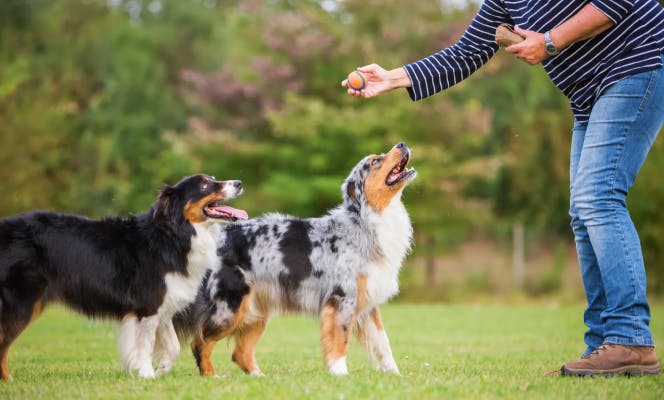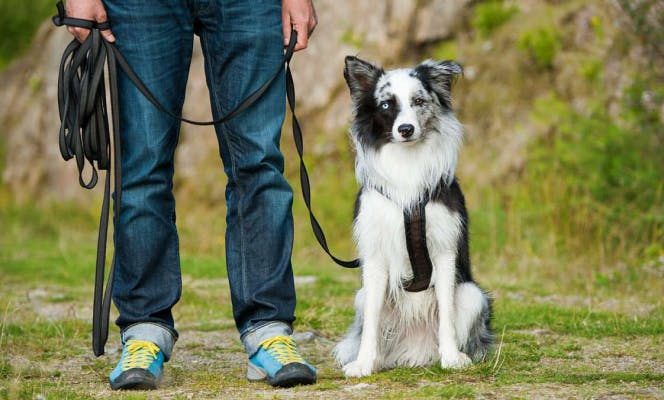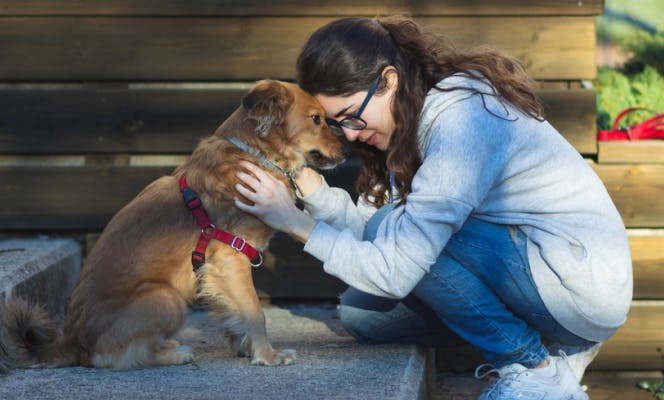How Do You Train an Emotional Support Dog?
By Mawoo Pets · 9 min read
Last updated: January 27th, 2024

Are you looking to train your dog to become an emotional support animal? Here's your definitive guide on this process!
If you’ve ever shared your life with a dog, you already know how calming their presence can be. While any dog owner can appreciate this quality in their pet, for those who suffer from mental or emotional conditions, dogs can be critical for their mental health and emotional stability.
That’s why mental health professionals often prescribe Emotional Support Animals (ESAs) to their patients. Due to their loyalty and trainability, dogs make wonderful ESAs, but it’s not unheard of for a cat, horse or even a bird to receive training as an ESA.
Training for an emotional support dog isn’t as specialized as training for a service dog. In fact, any dog (or animal) with the right temperament can learn to be an ESA! Let’s explore the basics of training an ESA at home, when to work with a professional trainer, and how to register your ESA.
How Do I Train My Dog to Be an ESA?
Training an emotional support dog involves teaching it to provide comfort and support to individuals with emotional or mental health conditions. Basic obedience training is essential, including commands like "sit," "stay," "down," and "come" to ensure good behavior in various situations. From there, your pup can graduate to training on more specific tasks.
Focus on Positive Reinforcement & Consistency
Your training method should revolve around positive reinforcement, repetition and consistency. These are the best techniques for training an emotional support dog. Studies show that positive reinforcement is much more effective in dogs than punishment, which can actually be detrimental to your efforts and possibly even lead to negative behaviors.
For example, punishing a dog for accidents in the house will teach it to hide when it has to go. Reinforcing the desired behavior of peeing outside with consistency and positive reinforcement does the opposite, helping the dog understand what you want it to do. Learning happens much more quickly this way.
As far as your dog is concerned, treats and praise are the way forward. Knowing that, let’s dive into some essential skills every ESA dog should know.
1. Potty Training (for Puppies)
Potty training is the perfect first step if your ESA is a puppy. Start by establishing a consistent bathroom and feeding schedule. Keep in mind that puppies can generally hold their bladders for one hour more per month of age, so you’ll want to set up your routine accordingly. That means a one-month-old puppy can hold it in for about an hour, and a six-month-old puppy can go for about six hours.
Consistency is key. Take your puppy to the same spot outside each time and reward it with praise and treats when it does its business outdoors. Restrict the pup to a small area when he can’t be supervised to help avoid accidents in the house.
In addition to regularly scheduled bathroom breaks, you should also take your pup outside immediately upon waking and after meals. When your pup does have an accident, just clean it up without a lot of fuss and continue with your potty schedule.

2. Basic Obedience Training
When it comes to basic obedience training, the first skill your pup needs to learn is how to walk on a leash. Use the leash every time you go outside. Most pups will fight it at first, but they usually catch on pretty quickly as long as you are consistent.
“Sit” is the next basic command your ESA needs to learn. Start with your pup on its leash standing in front of you. Hold a treat at nose level and gradually move it backward, saying “Sit”. When your pup sits down, reward him with the treat and lots of praise.
Repeat the steps above until your pup sits on command without requiring the movement of the treat. Gradually increase the length of time you expect him to sit before offering the treat and keep practicing every day until you feel he has the skill mastered.
Once your pup knows these basics, you can move on to more advanced skills like “stay,” “come,” “down", and “leave it”. Provide gentle guidance and positive reinforcement when introducing each new skill and then practice consistently until the skill becomes second nature.
As your dog becomes more confident, begin practicing these basic skills in different places, such as at the park or on walks through the neighborhood. Your ESA needs to learn to follow your commands at all times, even when surrounded by distractions.

3. Ongoing Socialization
Proper socialization is essential for every dog, but it’s especially crucial for ESAs who need to provide a calming presence for their owners in stressful public situations. Socialization is crucial for ESAs because it helps them become well-adjusted and confident companions. It also benefit you and family members who are providing the socialization by reducing feelings of loneliness and encouraging social interactions.
Socialization should begin when the pup is very young and continue throughout its lifetime. That's an absolutely critical step top train an emotional service dog.
The process of socialization simply involves introducing your pup to new stimuli on a regular basis. This can include everything from grooming and veterinary visits to new sounds, people, places and other animals. A slow, steady approach with lots of positive reinforcement is best.

4. Deep Pressure Therapy Training
Deep Pressure Therapy, or DPT, has been shown to calm those who suffer from general stress, anxiety, autism, and self-harming behaviors. DPT can reduce both the duration of an episode and the severity, making it an essential skill for all ESAs.
The principle behind Deep Pressure Therapy is to have the emotional support dog apply gentle pressure to the handler’s body, chest, or a specific body part. If your ESA is small, it can be taught to lay directly across your chest, lap, or alongside your body. Larger dogs can be taught to lay their head or front legs across your lap or legs.
Follow these steps to teach your Emotional Service Dog the basics of Deep Pressure Therapy:
Begin by teaching your dog to climb up and down on the couch using the verbal commands “Up” and “Down.” Reinforce the behavior with treats, praise, and repetition until it becomes second nature.
Next, sit on the couch and call your dog up next to you, placing it in the position you find most comforting. Encourage your pup to stay calmly in this position.
Gradually increase the amount of time you expect it to sit calmly, using the “down” command when you’re ready to stop. Repeat several times a day until the behavior becomes second nature, without requiring treats for motivation.
5. ESA Training by Qualified Trainers

If you feel you can’t train your ESA adequately on your own, consider enlisting the help of a pro. When you’re working with an older dog or pup who just isn’t catching on, hiring a professional trainer or behaviorist can be a great option.
Puppy classes, obedience classes and Canine Good Citizen training can also be extremely helpful if you need some extra guidance. These types of classes are readily available in most areas, and they’re a great way to socialize your dog while it learns essential skills.
Next Steps
If you have spoken to your health care provider and believe you qualify for an ESA, getting your dog is the logical next step. Take our Puppy Match Quiz to find your perfect breed match in minutes, based on your needs, personality and lifestyle. It’s the perfect place to begin your search for your new best friend and emotional support companion!
FAQs on Training Emotional Support Dogs
What Dog Breeds Are Best to Train as ESAs?
Labradors, Golden Retrievers, and Poodles are some of the most popular breeds to train as ESAs, but any dog with the right temperament can fit the bill. Most importantly, an emotional support dog should be docile, have a friendly personality, be eager to please, and be easy to train.
An ESA must also be well socialized, have good manners, and be able to remain calm and steady in times of stress. If your current dog meets these requirements, training it to be your ESA is totally doable since you already have an emotional bond!
Can I Train a Puppy to Become an ESA?
Getting a new puppy to train as your ESA is also a great option, and the two of you will form a strong bond throughout the training process. In fact, the simple act of establishing a regular training schedule and daily routine with your future ESA can provide focus and stability to a young dog.
For many who suffer from stress, anxiety and other emotional issues, a steady and reliable companion is the perfect fit. Others might benefit from an ESA that has some specialized training in anxiety and stress reduction. At the end of the day, the training requirements for your emotional support dog will depend on your individual needs.
What Are Some Basic Commands to Start Teaching My ESA Dog?
Basic commands such as "sit," "stay," "down," "come," and "paws up" can be helpful in training an emotional support animal. These commands are essential for ensuring that the dog is well-behaved and attentive, especially in public settings
Is Specialized Training Needed for ESAs?
No, specialized training for ESAs is not required like it is for service dogs. ESAs are focused on providing comfort to their owners, which they can do just by being present as loving companions. That said, it's good to have your ESA know basic obedience and be well-socialized, to make sure they're a well-functioning member of your family.
How Do I Get My Dog Certified as an ESA?
Legitimate ESAs must be prescribed by a healthcare professional. If you are undergoing treatment for one of the following health issues, you may qualify for an ESA:
Stress, anxiety or depression
PTSD
ADD
Autism
Bipolar, manic or cognitive disorders
Phobias or panic attacks
If you qualify, certifying your emotional support dog simply requires an ESA letter from your mental health professional on their official letterhead. The letter must state that the dog is required for your daily functioning and provide the therapist’s credentials, including a signature and license number. In most cases, your ESA letter should be renewed each year.
Be cautious of websites that allow you to purchase so-called “ESA Certificates” online. These may not be honored by management or officials without an accompanying ESA letter from your therapist.

How Is ESA Training Different from Service Dog Training?
Service dogs require specialized training to perform specific tasks for their owners, which is often expensive and requires the help of a qualified professional trainer. Such tasks include bringing medication, calling emergency services, and pulling wheelchairs. On the other hand, ESAs aren’t required to receive specialized training.
At a minimum, however, an ESA must be under the control of its handler at all times, be housebroken and have proper vaccinations to meet state, provincial and local laws. Aside from that, the level of training an ESA receives is up to its owner’s discretion.
What Are the Limitations of ESAs vs. Service Dogs?
Most public establishments and airlines are required to grant access to service dogs, but that’s not the case with ESAs. In fact, business owners and officials can deny entry to an ESA at their discretion, regardless of any certification.
That said, your certification letter serves as proof that your ESA’s presence is required in certain situations. Keeping it on hand may increase your dog’s chances of being welcomed in public places where dogs typically aren’t allowed.
By law, landlords cannot deny your rental application based on your legitimate ESA, even if dogs aren’t typically allowed in the building. Under the Fair Housing Act, ESA owners are also exempt from additional pet fees when renting. However, you will be held responsible for any damages caused by your ESA.
Until January of 2021, the Air Carrier Access Act protected both ESAs and service dogs. The law now allows ESAs to fly for free in the cabin only at the airline’s discretion. Although many airlines continue to accommodate qualified ESAs, they are no longer required to do so.
Keep in mind that additional documentation, such as health forms, may be required by landlords and other officials. Some locations may also require that the dog is in a carrier or wearing a muzzle in public places, depending on the situation.
When traveling, be sure to check ahead to ensure that you’re following all rules and regulations so your ESA isn’t denied entry. Wearing an identification vest or harness may help others to understand that your dog is there for a reason, but it’s not required.
Be aware that your ESA’s privileges can be revoked at any time if it’s aggressive or disruptive to other people and animals. To make public appearances go smoothly, always make sure your dog goes potty before entering any public place!

Related articles
Any questions? Get in touch!
We are here to support you every step of the way. Our concierge service is here daily to answer your questions!
Chat or speak with our team Mon-Sat 9a-9p ET.




